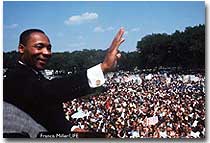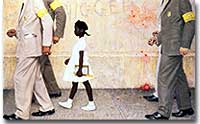
54. A New Civil Rights Movement

The Supreme Court's 1896 decision in Plessy v. Ferguson determined that "separate but equal" public facilities like restrooms and railroad cars were legal. The laws that resulted drove a further spike between the races in America.
In 1950, the United States operated under an apartheid-like system of legislated white supremacy.
Although the Civil War did bring an official end to slavery in the United States, it did not erase the social barriers built by that "peculiar institution."
Despite the efforts of Radical Reconstructionists, the American South emerged from the Civil War with a system of laws that undermined the freedom of African Americans and preserved many elements of white privilege. No major successful attack was launched on the segregation system until the 1950s.

Martin Luther King Jr. addresses a crowd during the March on Washington for Jobs and Freedom in 1963.
Beginning with the Supreme Court's school integration ruling of 1954, the American legal system seemed sympathetic to African American demands that their Fourteenth Amendment civil rights be protected. Soon, a peaceful equality movement began under the unofficial leadership of Dr. Martin Luther King Jr. A wave of marches, boycotts, sit-ins, and freedom rides swept the American South and even parts of the North.
Public opinion polls across the nation and the world revealed a great deal of sympathy for African Americans. The Eisenhower, Kennedy, and Johnson administrations gave the Civil Rights Movement at least tacit support. Although many obstacles to complete racial equity remained, by 1965 most legal forms of discrimination had been abolished.

Through his paintings, Norman Rockwell challenged people to address the problem of racism in America. The Problem We All Live With, a work from the early days of desegregation, depicts a little girl being escorted to school by federal marshals.
Legal equality did not bring economic equality and social acceptance. Gains made by civil rights activists did not bring greater unity in the movement. On the contrary, as the 1960s progressed, a radical wing of the movement grew stronger and stronger. Influenced by Malcolm X, the Black Power Movement rejected the policy of nonviolence at all costs and even believed integration was not a desirable short-term goal. Black nationalists called for the establishment of a nation of African Americans dependent on each other for support without the interference or help of whites.
Race-related violence began to spread across the country. Beginning in 1964, a series of "long, hot summers" of rioting plagued urban centers. More and more individuals dedicated to African American causes became victims of assassination. Medgar Evers, Malcolm X, and Martin Luther King Jr. were a few of the more famous casualties of the tempest.
Hope and optimism gave way to alienation and despair as the 1970s began. Many realized that although changing racist laws was actually relatively simple, changing racist attitudes was a much more difficult task.





